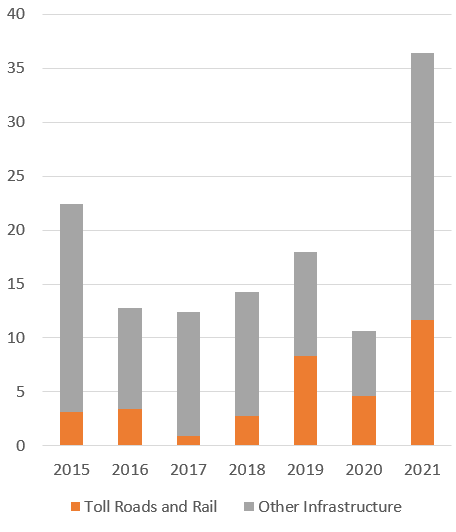
Inflation Risk Fuels Record-Level Sovereign Wealth and Pension Appetite for Unlisted Infrastructure
Posted on 12/29/2021
According to SWFI transaction data, sovereign wealth funds and public pension plans made a record amount of direct investments into the infrastructure sector. In 2021, sovereign funds and public pensions directly invested US$ 36.4 billion in the infrastructure sector vs. US$ 10.65 billion in 2020 and US$ 17.94 billion in 2019. This analysis leaves out infrastructure debt, opting to focus on infrastructure equity. Wealth funds and large public pensions rotated some assets out of public equities in late 2020 and aggressively targeted real assets, according to SWFI research. Toll roads, roads, and rail investments have also increased in proportion reaching US$ 11.63 billion in 2021 or about 32% of all infrastructure investments. The COVID-19 pandemic caused the deepest global economic recession in nearly a century and central banks and governments responded with aggressive stimulus. The stimulus created excess inflation as a result, which has forced more asset owners to seek out unlisted infrastructure to protect and grow their wealth. While airport investing was a major theme for sovereign wealth and public pension capital pre-pandemic, the means of transportation and railways have been leading the charge, especially in 2021. Government-owned operators of infrastructure are in a fortunate place as demand for these brownfield long-duration assets keeps growing, causing bidding wars. For instance, private fund managers may compete with pensions, or join sovereign funds in certain infrastructure deals.
Direct Sovereign Wealth Fund and Public Pension Transactions in Infrastructure – Billions USD

Filter: BuyerTypes: Sovereign Wealth Fund, Public Pensions. Exclude fund commitments and open market transactions. Billions USD. Access the data on SWFI.com (Global Asset Owner Terminal).
Global SWFs and Canadian pensions crave toll roads, road, and rail infrastructure investments. This is because infrastructure companies have a proven ability to pass through higher inflation to customers, typically with a 6-month to 15-month lag. A clear majority of infrastructure assets have an explicit link to inflation through regulation, concession agreements, or contracts. These cash-rich sovereign investors need to lockup their capital to earn stable returns that can beat inflation.
Asset owners are spending more time in riskier markets, where rules are being drawn out as the capital lines up. Canadian pension plans scoured the globe, even in emerging markets, for toll roads and highway developments. SWFI data has proven the thesis. For example, in 2021, Ontario Teachers’ Pension Plan Board and Canada Pension Plan Investment Board entered into a definitive agreement to acquire incremental stakes in Impulsora del Desarrollo y el Empleo en América Latina, S.A.B. de C.V. (BMV:IDEAL B-1, IDEAL). IDEAL owns, finances, and operates a portfolio of brownfield and greenfield toll road concessions, water treatment plants, multimodal transit terminals and Mexico’s largest electronic toll collection systems operator. IDEAL’s primary business is in the toll road sector where it operates a portfolio of roads strategically distributed to interconnect key urban centers, ports and production hubs across Mexico. With an office presence in India, Caisse de dépôt et placement du Québec (CDPQ) invested in the Shree Jagannath Expressway Private Limited in 2021. Mubadala Investment Company in 2021 took over a Rio de Janeiro subway concession.
Freight rail rates are largely unregulated but strong pricing power allows them to pass through many uncontrollable costs. Another Canadian colossal investor, PSP Investments, invested in Angel Trains Limited in 2021. Finally, toll roads are known as growth assets in terms of infrastructure investing and revenue is typically based on volume of users and is likely more sensitive to economic activity. Road and transport assets are typically beneficially in a rising inflation environment.
ADIA
Middle Eastern sovereign wealth funds and public pensions have goals to hit asset allocation targets in infrastructure, according to SWFI asset allocation data. Many of these institutional investors go through funds, but the larger pools of capital seek co-investment opportunities. These sovereign investors are trying to avoid being a mooncalf by plunking down mass piles of capital in various infrastructure investments in markets such as Asia, Australia, Europe, and the U.S. Emerging market countries like Indonesia and Turkey initiated beauty pageant like processes to lure public fund capital to pay for infrastructure. However, not all emerging markets are the same as Turkey battles a flailing Turkish lira, and Indonesia continues to reshape its image as a hospitable place for long-term capital after decades of various issues.
In December 2021, Sempra inked a deal to sell a non-controlling 10% interest in Sempra Infrastructure Partners (Sempra Infrastructure) to a subsidiary of the Abu Dhabi Investment Authority (ADIA) for US$ 1.785 billion in cash, subject to customary closing adjustments. The transaction implied an enterprise value for Sempra Infrastructure of US$ 26.5 billion, including asset-related debt of approximately US$ 8.6 billion. Sovereign funds like the Qatar Investment Authority (QIA) are eyeing port deal opportunities on the Eastern U.S. coast, while Kuwait PIFSS seeks high-performing infrastructure fund managers.
For 2022 and beyond, it is hard to imagine sovereign investors not playing a larger role in global infrastructure.
Keywords: Ontario Teachers Pension Plan, Caisse de depot et placement du Quebec.
